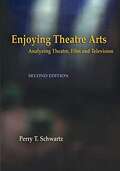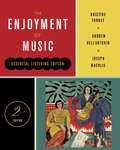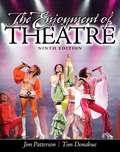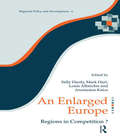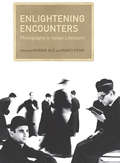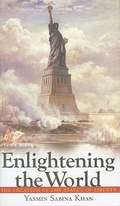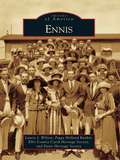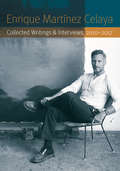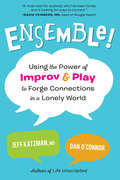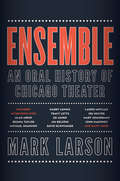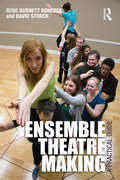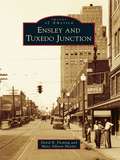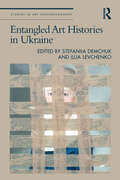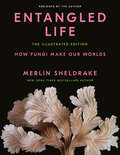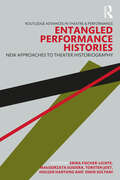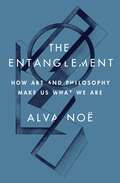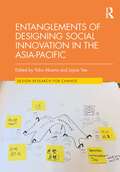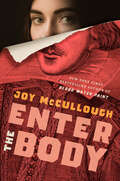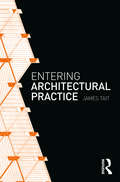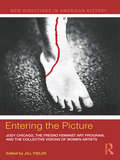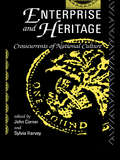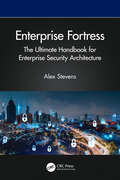- Table View
- List View
Enjoying Theatre Arts: Analyzing Theatre, Film and Television
by Perry T. SchwartzEnjoying Theatre Arts uses examples from Theatre, Film and Television to develop the unique analysis system detailed in this book. The text is designed as an introduction for students of the theatre arts as well as the general audience member. Contents Part One - The Theory And Analysis Art in Theatre Arts Aristotle's Six Elements of Drama Genre Based Narrative Structure Analysis Part Two - The Artistic Side Criticism The Writer The Director The Actor The Designers Part Three - The Business Side The Producer Film, Theatre, Television Business Structure The Artist/Craftsman and the Business.
The Enjoyment of Music: Essential Listening 2nd Edition
by Kristine Forney Andrew Dell'Antonio Joseph MachlisThe Enjoyment of Music: Essential Listening Edition offers instructors the flexibility to teach their course thematically or historically, and helps students acquire a lifelong interest in music. With Total Access, all the music and media resources students need are automatically included with every new copy of the text.
The Enjoyment of Theatre (Ninth Edition)
by Jim A. Patterson Tim DonohueBrings theatre to life for students by showing the relationship and relevance of the performing arts to their everyday lives The Enjoyment of Theatre's balanced coverage of performance and history provides a comprehensive and accessible introduction to theatre for both majors and nonmajors. This text establishes the aesthetic underpinnings of theatre art and then explores performance and production topics such as playwriting, acting, directing, design, and the theatre industry. The Enjoyment of Theatre also covers the full span of theatre's 2,500-year history. The authors make theatre come alive for students by showing them how theatre is relevant to their everyday lives. Learning Goals: Upon completing this book, readers will be able to: Understand today's theatre and the social impact of the theatre since its inception Explore theatre's cultural and economic context
An Enlarged Europe: Regions in Competition? (Regions and Cities #No. 6)
by Sally Hardy Mark Hart Louis Albrechts Anastasios KatosThe political and economic geography of Europe is changing - the European Community is expanding its boundaries towards EFTA and is resuming a closer association with Central and Eastern European regions engaged in radical restructuring. As EC integration accelerates there is the prospect of intensified inter-regional competition. This book, divided into five parts, examines in detail the changes and the challenge for policy makers. The introduction draws out the central themes of the book, addressing EC regional performance and future indicators, the enlargement and changing map of Europe and the implications for the EC of Eastern European changes. The second part deals with EC issues, particularly focusing on the economic and spatial impact of European integration. Part 3 addresses Eastern European issues, and Part 4 covers the Peripheral Regions. The final part is devoted to a policy debate, concluding with a policy agenda for the forthcoming decade.
Enlightening Encounters
by Giorgia Alu Nancy PedriEnlightening Encounters traces the impact of photography on Italian literature from the medium's invention in 1839 to the present day. Investigating the ways in which Italian literature has responded to photographic practice and aesthetics, the contributors use a wide range of theoretical perspectives to examine a variety of canonical and non-canonical authors and a broad selection of literary genres, including fiction, autobiography, photo-texts, and migration literature. The first collection in English to focus on photography's reciprocal relationship to Italian literature, Enlightening Encounters represents an important resource for a number of fields, including Italian studies, literary studies, visual studies, and cultural studies.
Enlightening the World: The Creation of the Statue of Liberty
by Yasmin Sabina KhanThe Statue of Liberty has been a symbol of US democratic ideals since 1886. Based on extensive research including travels to France where Liberty Enlightening the World was created, an independent scholar chronicles the story behind its conception, construction, and gifting to the US in the wake of the Civil War. Khan showcases sculptor Auguste Bertholdi, engineer Gustave Eiffel, poet Emma Lazarus, and fundraiser/publisher Joseph Pulitzer, among the many individuals involved. The book features new details about Liberty's design and b&w images. Annotation ©2010 Book News, Inc. , Portland, OR (booknews. com)
Ennis
by Ellis County Czech Heritage Society Laurie J. Wilson Ennis Heritage Society Peggy Holland RankinIn 1871, the Houston and Texas Central Railroad reached what would soon become Ennis, Texas. A year later, the city was officially established and named for Cornelius Ennis, a Houston and Texas Central Railroad tycoon. It became home to many, including a number of Civil War veterans. Czech immigrants also made Ennis their home, adding their rich cultural heritage to this growing city. In its "Wild West" days, there were as many as 13 saloons in the city, and it became a popular train stop for as many as 10 passenger trains a day. A thriving cotton industry brought thousands to the downtown district on Trade Days. Family, tradition, and a strong sense of community have always been the foundation from which Ennis has prospered. This remains evident with yearly events such as the Bluebonnet Trails and Festival, the National Polka Festival, and the Christmas Parade of Lights.
Enrique Martínez Celaya: Collected Writings and Interviews, 2010-2017
by Enrique Martínez CelayaThis collection, spanning nearly a decade of artistic activity, features selections of writings that trace the intellectual influences and track the development of one of the more formidable and productive minds in the contemporary art world. The writings comprise Enrique Martínez Celaya&’s public lectures; essays; interviews; correspondence with artists, critics, and scholars; artist statements; blog posts; and journal entries. These texts were written during Martínez Celaya&’s appointment as Visiting Presidential Professor at the University of Nebraska; Roth Distinguished Visiting Scholar at Dartmouth College; and, most recently, as the first Provost Professor of Humanities and Arts at the University of Southern California. Marked by Martínez Celaya&’s encyclopedic curiosity and considerable knowledge about the world, these writings and interviews explore the role of art in life, evaluate texts by other modern and contemporary artists and thinkers, and reveal the artist&’s deep engagement with artistic, philosophical, and literary lines of inquiry.
Ensayo sobre la muerte: Drácula, o el precio de la inmortalidad
by Horacio RosattiA partir de la figura de Drácula y sus diversas representaciones, este riquísimo ensayo explora las inquietudes sociales y culturales en torno al tema de la muerte; recobra los aportes de la filosofía, el derecho, la ciencia y el arte; plantea los caminos por los que hoy discurre la búsqueda de la inmortalidad y reflexiona sobre la incidencia de la tecnología en el logro de una vida humana cada vez más extensa. «Me enseñáis que este universo prestigioso y abigarrado se reduce al átomo, y que el átomo se reduce al electrón. Las líneas suaves de estas colinas y la mano del crepúsculo sobre este corazón agitado me enseñan mucho más.»Albert Camus, El mito de Sísifo El avance de la ciencia ha extendido el promedio de vida a niveles impensados. Paradójicamente, nuestros miedos se han desplazado del temor a la muerte al temor a los inconvenientes que nos depararía una existencia demasiado prolongada. ¿Habrá muerte en el futuro? ¿Es cierto que viviremos doscientos años? ¿Cómo será esa vida? ¿Podrá ser conjurada virtualmente la ausencia física de los seres que se han ido? ¿Qué significa hoy morir? ¿No respirar, no sentir, no pensar? Horacio Rosatti centra el análisis en la figura espectral del vampiro, ese ícono contemporáneo de la literatura y el cine capaz de subvertir los límites de lo biológico y lo moral que encarnaría tanto el miedo a la muerte como a la inmortalidad. La ausencia de un cuerpo que pueda reflejarse en el espejo o exponerse a la luz del día ¿no es, en su caso, el precio de vivir por siempre? Este riquísimo ensayo explora las inquietudes sociales y culturales en torno al tema de la muerte; recobra los aportes de la filosofía, el derecho, la ciencia y el arte; plantea los caminos por los que hoy discurre la búsqueda de la inmortalidad y reflexiona sobre la incidencia de la tecnología en el logro de una vida humana cada vez más extensa.
Ensemble!: Using the Power of Improv and Play to Forge Connections in a Lonely World
by Jeff Katzman Dan O'ConnorDrawing on a combined expertise in improvisational theatre and psychiatry, author team Dan O'Connor and Dr. Jeff Katzman show readers how improv skills are the perfect antidote to loneliness and isolation.I know what you're thinking: Hold on...improv? Like getting on a stage in front of an audience? What if that's not my thing?Don't worry: this isn't a book about becoming an improv theater expert, and it's not really a book about performing. It's a book about loneliness--about our feelings of disconnection and isolation, ones that we may have been experiencing since long before the pandemic. More importantly, it's a book about becoming unlonely--by borrowing from the collaborative and creative tools of improv.Authors of Life Unscripted Jeff Katzman, a professor of psychiatry at the University of New Mexico, and Dan O'Connor, multifaceted actor, writer, and director, have created a process they call Ensembling that helps us build an ensemble of relationships in our lives and more deeply enjoy the groups we already belong to. This is a process of becoming a little vulnerable with each other, and of embracing the moment in which we find ourselves. Drawing on concepts from narrative improvisational theatre and depth psychology, the authors present us with the skills we need to connect with each other more actively and meaningfully. To ensemble or not to ensemble--that is not a question. With the rise of loneliness and isolation in an increasingly virtually connected society, we must find ways to come together. We must ensemble!
Ensemble: An Oral History of Chicago Theater
by Mark LarsonThis definitive history brings Chicago’s celebrated theater and comedy scenes to life with stories from some of its biggest stars spanning sixty-five years.Chicago is a bona fide theater town, bursting with vitality that thrills local fans and produces generation after generation of world-renowned actors, directors, playwrights, and designers. Now Mark Larson shares the rich theatrical history of Chicago through first-person accounts from the people who made it.Drawing from more than three hundred interviews, Larson weaves a narrative that expresses the spirit of Chicago’s ensemble ethos: the voices of celebrities such as Julia Louis-Dreyfus, Ed Asner, George Wendt, Michael Shannon, and Tracy Letts comingle with stories from designers, composers, and others who have played a crucial role in making Chicago theater so powerful, influential, and unique.Among many other topics, this book explores the early days of the fabled Compass Players and the legendary Second City in the ‘50s and ‘60s; the rise of acclaimed ensembles like Steppenwolf in the ‘70s; the explosion of storefront and neighborhood companies in the ‘80s; and the enduring global influence of the city as the center of improv training and performance.
Ensemble Theatre Making: A Practical Guide
by Rose Burnett Bonczek David StorckEnsemble Theatre Making: A Practical Guide is the first comprehensive diagnostic handbook for building, caring for, and maintaining an ensemble. Successful ensembles don’t happen by chance; they must be created, nurtured, and maintained through specific actions. Achieving common goals in rehearsal and performance requires group trust, commitment and sacrifice. Ensemble Theatre Making is a step-by-step guide to these processes. Candid and direct, it considers: how to plan and prepare for ensemble work; the essential building blocks of ensemble; how to identify ensemble behaviors; techniques for responding to, and positively redirecting those behaviors. Tools, techniques and recipes for rethinking ensemble redefine it as a grounded practice, rather than a question of luck. Above all, this significant new work brings decades of experience to the sometimes mystifying questions of what creates ensemble bonds, how to protect them, and how to fix them when they break.
Ensley and Tuxedo Junction
by David B. Fleming Mary Allison HaynieWith dreams of building a vast steel production operation, Memphis planter Enoch Ensley founded a city in the wooded valley at the heart of Jefferson County, Alabama. He named the city Ensley, after himself, and established the Ensley Land Company to acquire and develop 4,000 acres for industrial facilities and a town. As field workers left their farms to work in steel mills and businesses sprang up on the valley floor, Ensley became a diverse place of hopes and desires. A strong community of churches, businesses, civic clubs, and neighborhoods developed around the factories and railroads. Jazz music was the social thread of Ensley's African American community, known as Tuxedo Junction. Musicians such as Erskine Hawkins famously mastered the style. The annexation of Ensley into Birmingham established the "Magic City" as the largest and wealthiest in Alabama and the heart of the Southern steel manufacturing economy.
Entangled Art Histories in Ukraine (Studies in Art Historiography)
by Stefaniia Demchuk Illia LevchenkoThis book explores ideologies, conflicts and ideas that underpinned art historical writing in Ukraine in the 20th century.Disciplinary beginnings testify both to its deep connection to Krakow, Saint Petersburg and especially Vienna with its school of art history and originality of theoretical thought. Art history started as another imperial project in Ukraine, but ultimately transformed into the means of assertion of national identity. The volume looks closely at the continuity and ruptures in scholarship caused by the establishment of Soviet power and challenges a number of existing stereotypes like total isolation under Communist rule and strict adherence to a Marxist-Leninist methodology. It showcases intellectual exchanges through published work, personal contacts and ways to resist the politically enforced methodology. Despite keeping the focus on one country, it contributes to understanding the development of art history as an academic discipline in Europe more generally. It also uncovers unknown or little-researched personal and academic connections between art historians from Ukraine and their peers abroad. Starting with the 19th-century quest for the method and proceeding by disentangling the complexities of the 20th century, the authors move on to the specifics of historiography after the formal collapse of the USSR. The volume transgresses purely academic boundaries and tackles the development of the discourse in periodicals, exhibition spaces and public discussions.Thus, the findings will be pertinent to all interested in politics, art history, museum studies, intellectual history, historiography and Eastern European studies.
Entangled Life: How Fungi Make Our Worlds
by Merlin SheldrakeMerlin Sheldrake&’s New York Times bestseller, Entangled Life, is now a lavish visual journey into the hidden lives of fungi.When we think of fungi, we likely think of mushrooms. But mushrooms are only fruiting bodies, analogous to apples on a tree. Most fungi live out of sight yet make up a massively diverse kingdom of organisms that supports and sustains nearly all living systems. Fungi provide a key to understanding the planet on which we live, and the ways we think, feel, and behave. In the first edition of the mind-bending, &“gorgeous&” (Margaret Atwood), &”brilliant [and] entrancing&” (The Guardian) Entangled Life, Sheldrake introduced us to this mysterious but massively diverse kingdom of life. This new edition, abridged from the original, features over 100 full-color images that bring the spectacular variety, strangeness and beauty of fungi to life as never before. Fungi throw our concepts of individuality and even intelligence into question. They are metabolic masters, earth makers, and key players in most of life&’s processes. They can change our minds, heal our bodies, and even help us remediate environmental disaster. In vivid, surprising images, Sheldrake reveals how these extraordinary organisms—and our relationships with them—are changing our understanding of how life works.
Entangled Performance Histories: New Approaches to Theater Historiography (Routledge Advances in Theatre & Performance Studies)
by Erika Fischer-Lichte Małgorzata Sugiera Torsten Jost Holger Hartung Omid SoltaniEntangled Performance Histories is the first book-length study that applies the concept of "entangled histories" as a new paradigm in the field of theater and performance historiography. "Entangled histories" denotes the interconnectedness of multiple histories that cannot be addressed within national frameworks. The concept refers to interconnected pasts, in which historical processes of contact and exchange between performance cultures affected all involved. Presenting case studies from across the world—spanning Africa, the Arab-speaking world, Asia, the Americas and Europe—the book’s contributors systematically expand, exemplify and examine the concept of "entangled histories," thus introducing various innovative concepts, theories and methodologies for investigating reciprocally consequential processes of interweaving performance cultures from the past. Bringing together examples of entanglements in theater and performance histories from a broad variety of geographical and historical backgrounds, the book’s contributions build together a broad basis for a possible and necessary paradigmatic shift in the field of theater and performance historiography. Ideal for researchers and students of history, theater, performance, drama and dance, this volume opens novel perspectives on the possibilities and challenges of investigating the entangled histories of theater and performance cultures on a global scale.
The Entanglement: How Art and Philosophy Make Us What We Are
by Alva NoëWhy human nature is an aesthetic phenomenon—and why we need art and philosophy to understand ourselvesIn The Entanglement, philosopher Alva Noë explores the inseparability of life, art, and philosophy, arguing that we have greatly underestimated what this entangled reality means for understanding human nature.Life supplies art with its raw materials, but art, Noë argues, remakes life by giving us resources to live differently. Our lives are permeated with the aesthetic. Indeed, human nature is an aesthetic phenomenon, and art—our most direct and authentic way of engaging the aesthetic—is the truest way of understanding ourselves. All this suggests that human nature is not a natural phenomenon. Neither biology, cognitive science, nor AI can tell a complete story of us, and we can no more pin ourselves down than we can fix or settle on the meaning of an artwork. Even more, art and philosophy are the means to set ourselves free, at least to some degree, from convention, habit, technology, culture, and even biology. In making these provocative claims, Noë explores examples of entanglement—in artworks and seeing, writing and speech, and choreography and dancing—and examines a range of scientific efforts to explain the human.Challenging the notions that art is a mere cultural curiosity and that philosophy has been outmoded by science, The Entanglement offers a new way of thinking about human nature, the limits of natural science in understanding the human, and the essential role of art and philosophy in trying to know ourselves.
Entanglements of Designing Social Innovation in the Asia-Pacific (Design Research for Change)
by Yoko AkamaRooted in the places, cultures, histories, and wisdom of the diverse Asia-Pacific region, this book gathers heterogeneous practices of designing social innovation that address various social, political, and environmental challenges. In contrast to dominant notions of design from the Global North that evolved through industrialisation and modernist thinking, the examples in this book speak to designing that is embodied, relational, temporal, ontological, and entangled deeply with ecologies. This edited volume shares rich and detailed stories from Aotearoa New Zealand, Cambodia, Indonesia, Japan, Malaysia, Myanmar, the Philippines, Samoa, Thailand, Vanuatu and a continent now called Australia, that offer honest and critical reflections from practitioners and scholars on designing social innovation. Contributors explore issues of ethics, politics, and positionality in their work. This book highlights the importance of respecting multiple knowledge streams, worldviews, and practices situated in a place. This then supports a plurality of designing social innovation. In all, this book offers ways to sharpen focus on entangled pluralities as a central condition for designing. It is a contribution of hope and inspiration that are becoming more urgently needed in the volatile uncertainties of this world. This book will be of interest to scholars working in social innovation, service design, social design, participatory design, design anthropology, and Asian studies.
Enter The Body: Women and Representation on Shakespeare's Stage
by Carol Chillington RutterEnter the Body offers a series of provocative case studies of the work women's bodies do on Shakespeare's intensely body-conscious stage. Rutter's topics are sex, death, race, gender, culture, politics, and the excessive performative body that exceeds the playtext it inhabits. As well as drawing upon vital primary documents from Shakespeare's day, Rutter offers close readings of women's performance's on stage and film in Britian today, from Peggy Ashcroft's (white) Cleopatra and Whoopi Goldberg's (whiteface) African Queen to Sally Dexter's languorous Helen and Alan Howard's raver 'Queen' of Troy.
Enter the Body
by Joy McCullough&“At once tender, poetic and ferocious, Enter The Body breathes new life into the Bard&’s most tragic heroines. More than a tribute to Shakespeare, this kaleidoscopic, ambitious novel-in-verse gives Juliet, Ophelia, Cordelia, and Lavinia the chance to tell their own stories full of passion, justice, sisterhood, and love. Simply spectacular.&”—Michael L. Printz Award winner Laura Ruby, author of Bone GapIn the room beneath a stage's trapdoor, Shakespeare&’s dead teenage girls compare their experiences and retell the stories of their lives, their loves, and their fates in their own words. Bestselling author Joy McCullough offers a brilliant testament to how young women can support each other and reclaim their stories in the aftermath of trauma.
Entering Architectural Practice
by James TaitEntering Architectural Practice is a practical and honest guide for architecture students, entering the world of architectural practice. There is often a disconnection between what you are taught in architecture school and the actual practice of architecture in the workplace. As both a practising architect and architecture school tutor, the author has first-hand experience of this disconnection and so helps students bridge this divide between academia and practice. Focused on providing industry insight, dispelling myths, and above all providing a combination of reality and hope to students of architecture entering the workplace, the book is beautifully and richly illustrated, providing a compelling visual story alongside the invaluable information it imparts. Serious but enjoyable, thoroughly researched but highly approachable, this book is simply essential reading for every individual about to embark on a career in practice.
Entering the Picture: Judy Chicago, The Fresno Feminist Art Program, and the Collective Visions of Women Artists (New Directions in American History)
by Jill FieldsIn 1970, Judy Chicago and fifteen students founded the groundbreaking Feminist Art Program (FAP) at Fresno State. Drawing upon the consciousness-raising techniques of the women's liberation movement, they created shocking new art forms depicting female experiences. Collaborative work and performance art – including the famous "Cunt Cheerleaders" – were program hallmarks. Moving to Los Angeles, the FAP produced the first major feminist art installation, Womanhouse (1972). Augmented by thirty-seven illustrations and color plates, this interdisciplinary collection of essays by artists and scholars, many of whom were eye witnesses to landmark events, relates how feminists produced vibrant bodies of art in Fresno and other locales where similar collaborations flourished. Articles on topics such as African American artists in New York and Los Angeles, San Francisco’s Las Mujeres Muralistas and Asian American Women Artists Association, and exhibitions in Taiwan and Italy showcase the artistic trajectories that destabilized traditional theories and practices and reshaped the art world. An engaging editor’s introduction explains how feminist art emerged within the powerful women’s movement that transformed America. Entering the Picture is an exciting collection about the provocative contributions of feminists to American art.
Enterprise and Heritage: Crosscurrents of National Culture
by John CornerThe phenomena of `enterprise' and `heritage' might at first thought seem unrelated: this book sets out to show that the two concepts are not only related but deeply interdependent. If `enterprise' can be used to define the official encouragement of the values of the market society, then the growth of the heritage industry can be seen as a manifestation of the entrepreneurial spirit - marketing the past so that it is accessible to the man or woman in the street. Using case studies, commentary and critique, the contributors to this lively volume discuss the importance of `enterprise' and `heritage' in British social and cultural life, with examples drawn from film, television, literature, urban planning, architecture, government advertising, information technology and tourism.
Enterprise Augmented Reality Projects: Build real-world, large-scale AR solutions for various industries
by Jorge R. Benito Enara Artetxe GonzalezDesign end-to-end AR solutions for domains such as marketing, retail, manufacturing, tourism, automation, and training Key Features Use leading AR development frameworks such as ARCore, ARKit, and Vuforia across key industries Identify the market potential of AR for designing visual solutions in different business sectors Build multi-platform AR projects for various platforms such as Unity, iOS, and Android Book Description Augmented reality (AR) is expanding its scope from just being used in mobile and game applications to enterprise. Different industries are using AR to enhance assembly line visualization, guide operators performing difficult tasks, attract more customers, and even improve training techniques. In this book, you'll gain comprehensive insights into different aspects of developing AR-based apps for six different enterprise sectors, focusing on market needs and choosing the most suitable tool in each case. You'll delve into the basics of Unity and get familiar with Unity assets, materials, and resources, which will help you build a strong foundation for working on the different AR projects covered in the book. You'll build real-world projects for various industries such as marketing, retail, and automation in a step-by-step manner. This will give you hands-on experience in developing your own industrial AR apps. While building the projects, you'll explore various AR frameworks used in the enterprise environment such as Vuforia, EasyAR, ARCore, and ARKit, and understand how they can be used by themselves or integrated into the Unity 3D engine to create AR markers, 3D models, and components of an AR app. By the end of this book, you'll be well versed in using different commercial AR frameworks as well as Unity for building robust AR projects. What you will learn Understand the basics of Unity application development and C# scripting Learn how to use Android Studio along with ARCore and Sceneform to build AR prototypes for Android devices Enable AR experiences on the web with ARCore and WebAR Explore emerging AR authoring tools such as Augmented Class! for education Understand the differences and similarities between handheld and head-mounted display (HMD) environments and how to build an app for each target Become well versed in using Xcode with ARKit and SceneKit to develop AR portals for iOS devices Who this book is for This book is for anyone interested in emerging and interactive technologies or looking to build AR applications for any domain. Although, no prior augmented reality experience is required, having some skills in object-oriented programming (OOP) will be helpful.
Enterprise Fortress: The Ultimate Handbook for Enterprise Security Architecture
by Alex StevensEnterprise Fortress is a comprehensive guide to building secure and resilient enterprise architectures, aimed at professionals navigating the complex world of cybersecurity. Authored by cybersecurity leader Alex Stevens, the book brings together his experience of over 20 years, blending technical expertise with business strategy. It covers everything from foundational principles to advanced topics, focusing on aligning security with organisational goals. What sets this book apart is its practical, real-world focus – grounded in hands-on experience and strategic insights, it provides actionable advice that can be immediately applied.This book equips readers with the knowledge to tackle the evolving landscape of cybersecurity. Whether you’re developing security frameworks, handling governance and compliance, or leading a security team, Enterprise Fortress has you covered. By combining best practices with innovation, it provides tools and strategies for both current challenges and future threats.Key Features: Clear, step-by-step instructions on designing and implementing enterprise security architectures. Practical frameworks for integrating security into the business strategy. Detailed insights into governance, risk management, and compliance with regulations like GDPR and ISO 27001. Case studies that highlight real-world challenges and solutions from various industries. Exploration of advanced topics like security automation, orchestration, and emerging cyber threats. Guidance on building and leading effective cybersecurity teams and fostering a security-aware culture within organisations. Enterprise Fortress is perfect for cybersecurity professionals, IT leaders, enterprise architects, and business executives responsible for securing their organisations. Whether you’re an experienced architect or new to the field, this book offers the technical know-how and leadership insights to help you strengthen your organisation’s security posture and stay ahead of emerging threats.
